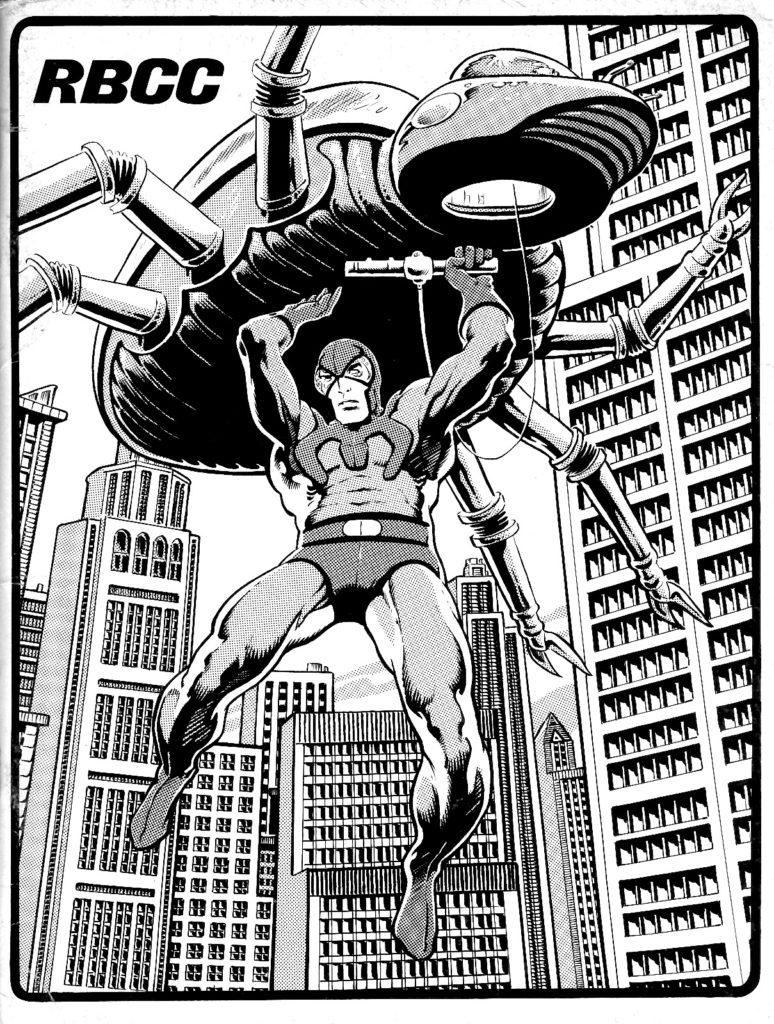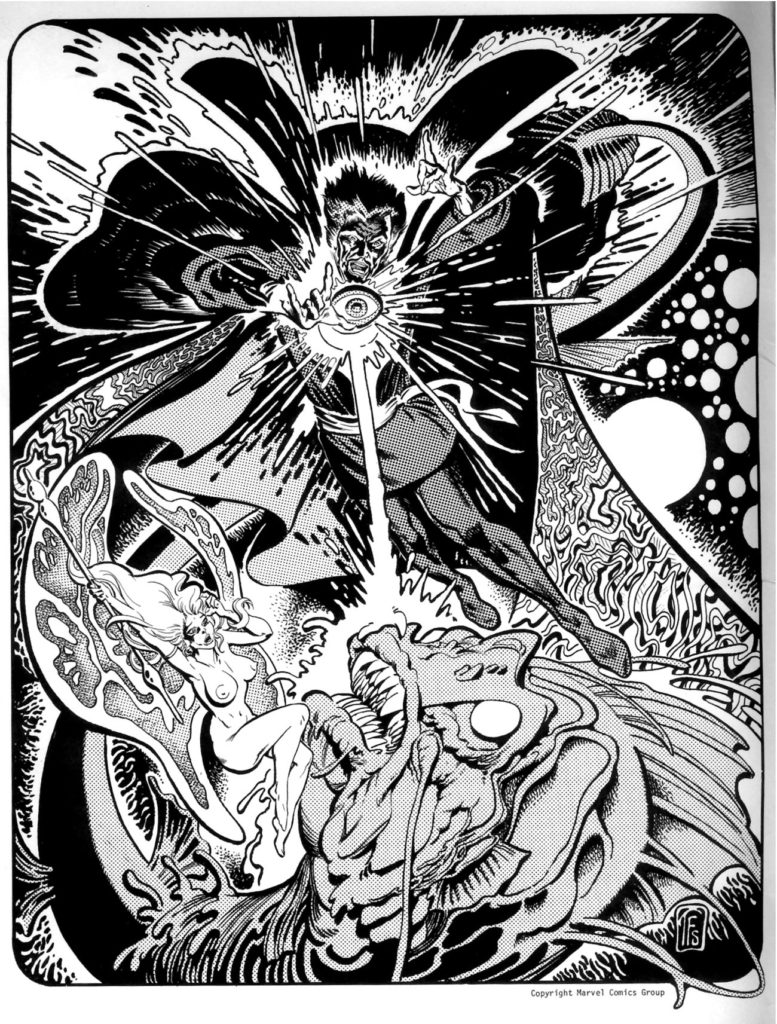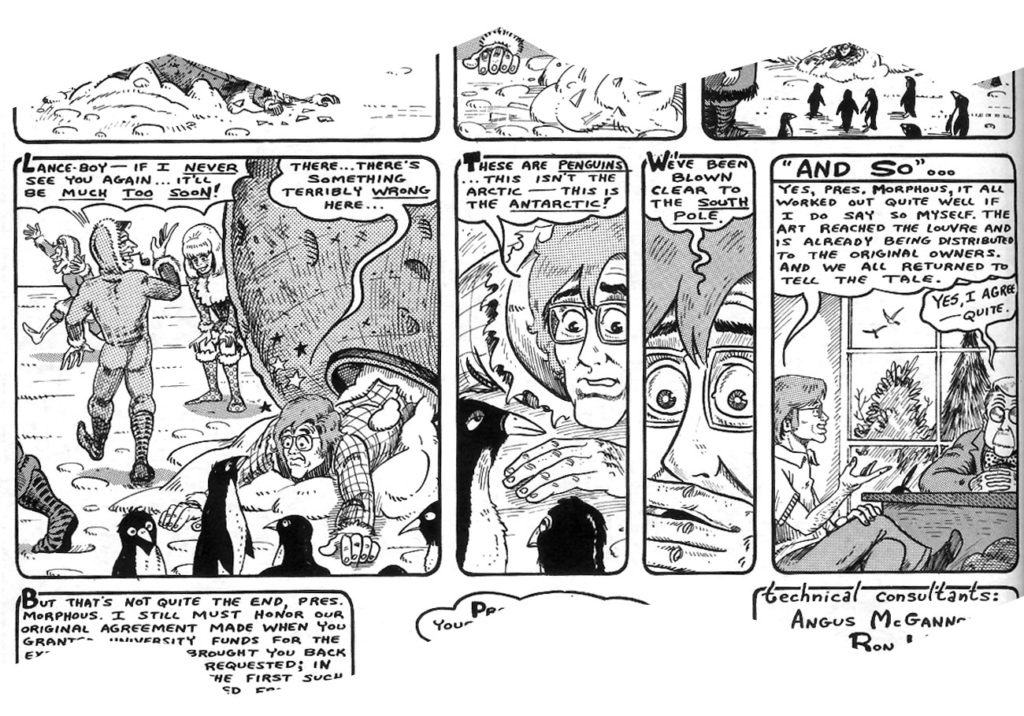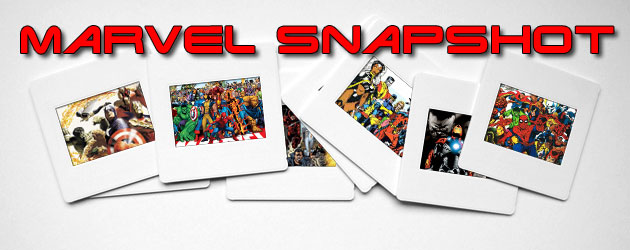RBCC 135 (April 1977)
Publisher and editor: James Van Hise
Very few fanzines had longer runs than RBCC (Rocket’s Blast ComiCollector). Perhaps The Comic Reader and The Buyer’s Guide are the only ones that were around longer. Our featured zine was started in the early sixties by G. B. Love, who did not let cerebral palsy stop him from sharing his love of movies and comics with the world. Originally called Rocket’s Blast, it merged with another fanzine and became RBCC. G. B. Love died at the age of 61 on January 17, 2001. James Van Hise, who worked for G. B. Love from 1970-1974, took over the fanzine in ’74 with issue 113. James was only 24 at the time, and he stayed with the zine for the next forty issues. It was a run filled with informative columns, art from future pros of the comic business, and a pure love of film and comics. And unlike many zines, it ran on time, month in and month out. No mean feat, considering the publisher’s young age.
I chose to profile this particular issue primarily for two reasons: It includes work from Mike Zeck, who would go on to do many books for Marvel, and it features illustrations and stories from Ron Wilber, whose detailed and often humorous work stood out visually from his peers. I will profile other issues later, as many other artists were regulars, such as Marc Hempel, Ralph Fowler, John Fantucchio, Stephen Fabian and more.
Though early issues of the zine were similar to later publications like The Buyer’s Guide in that it seemed the original content was secondary to the ads, when Van Hise took over, he made a concerted effort to reverse that ratio. Van Hise published many talented artists in his fifty issue run, including frequent cover artist Mike Zeck. Van Hise considers this Miami “local boy made good” one of his best finds. Zeck was kind enough to take time out of his busy schedule to answer a few standard questions I ask of most participants. When I asked him of his first published zine work, he said, “…I would have been around 18 years old and in my first year of art school. My figure instructor, who was also a comics fan, contributed spot illustrations to various Edgar Rice Burroughs fan publications. He suggested I do a few for submission. I think my first illo was published in one called Erbania. It’s always a big deal when that first piece is accepted for publication.”
Zeck notes that there wasn’t much of a (comic) community in south Florida at that time, and that he was pretty much on his own, and the majority of his fan work ended up in RBCC. Some of Zeck’s favorite zine artists of that period included Richard Corben, Kerry Gammill, John Byrne, and this issue’s interview subject, Tom Sutton. Though Zeck had landed a few jobs at Charlton comics a few years earlier, RBCC was instrumental in getting work at Marvel. Marvel writer Roy Thomas, who was a RBCC subscriber, saw one of Zeck’s illustrations (a Conan back cover) and asked to use it in Savage Sword of Conan, which became Zeck’s first published Marvel work. Zeck’s work in this issue of RBCC includes a Blue Beetle front cover that exemplifies his sinuous line, low angle point of view and eye for good composition (as well as intelligent use of that now obsolete tool, zip-a-tone). Also included is a full-page Batman illustration functioning as the contents page (seen below, with various column titles added by me) and a Spider-Man spot illo (in a future column I will spotlight the previous issue, as it features a beautiful Flash Gordon strip which showcases Zeck’s sumptuous inks and halftones). I actually like Zeck’s fanzine work a little better than his pro work, as I feel his style got crushed in the assembly line process of professional comics. Van Hise feels the lack of good inkers might be the culprit, but Zeck himself states it was more likely the deadlines. He says his entry into Marvel consisted of picking up the slack of other artists’ missed deadlines, having to pencil a 22 page story in as little as a week! In spite of that, he thinks that inkers such as John Beatty, Gene Day, and Bob McLeod all did fine jobs on his pencils. He also says that those years in the fanzines were “unique times,” and that the work featured “an intensity that’s rarely repeated at the pro level.” In recent years, Zeck’s workload has moved towards uncredited licensing work, and is almost entirely digital. Instead of seeing his work in your local comics shop, Zeck says, “If you’re walking down the grocery aisle though and see Batman on a cereal box or a Spaghettio’s can, you just might be looking at some of my recent work.”
Tom Sutton is probably best known for his horror work with Charlton. Sutton’s frenetic and usually moody work is unlike most other artists, and certainly stands out in the pages of most any Charlton comic. This issue of RBCC features an interview with the self professed shut-in and hater of warm weather. The art from Sutton includes an appropriately psychedelic Dr. Strange inside front cover illustration (see below), a minimalistic full page Dejah Thoris doppelganger with a reptilian partner, an energetic full page Red Sonja piece which prefigures outline heavy work from current artists such as Bruce Timm, as well as a couple of half page illustrations. The interview is lengthy, covering Sutton’s Charlton work primarily, but also his work for Warren, Skywald, and mainstream commercial work. Sutton is acerbic, self depreciating, and darn funny. His distaste for summer’s heat is covered several times, culminating in a quote about inking an issue while actually taking a cold bath!
Other artists in this issue include Ron Wilber (see sidebar below), Don Newton/Bob Layton, Hilary Barta, fandom stalwart Keno Don Rosa (the final installment of his “133 part” epic, “The Pertwillaby Papers,” which you can see a snippet of below), and ends with a back cover rendition of The Shadow by Frank Hamilton.
The columns’ subjects include a Ron Wilber profile, critiques ofcurrent books, magazines and fanzines (Critique by Van Hise), contracts in comics (Keyhole, by Gary Brown), checklists of Walt Disney Comics/Ellery Queen, tv series (Don Rosa’s Information Center), Stan Lee and comic strip artist Cliff Sterrett (R. C. Harvey’s Comicopia), Australian comics (Comic Collector’s Comments by Howard P. Seigel), Wally Wood (Van Hise’s The EC Artist Collector), the virility of the comic convention (Point/Counterpoint by Doug Haines and John Baglem), as well as the requisite ads.
As you can see from this column, RBCC had no shortage of material, talent, or in the case of editor and publisher Van Hise, drive. One of the very few fanzines that can claim to be printed monthly with very few publication deadlines missed (if any), RBCC stood almost alone in its field. It was very tough to get into the pages of this zine, and from the quality of this issue alone, one can see why.
Sidebar: Ron Wilber
Ron Wilber is a funny fellow. His art is funny, his writing is funny, and his answers to my questions were funny. The artist may be self depreciating to the nth degree, but his art stands out, if only for its wealth of detail. His meticulous approach to his craft comes from a practical lack of the art supplies… specifically, zip-a-tone. To all you young whipper-snappers out there, a sheet of zip-a-tone was a sheet of clear plastic with various patterns printed on them (dots, lines, and much more). In older comics (especially those printed only in black and white), the tones you see were most likely done using this tool. You laid it down over your art and either traced it and then cut it with an x-acto knife, or just started cutting. Then, you peeled it and stuck it down right on your art. Today of course, this is done digitally. Back then though, it was the only way your average artist could get tones like this on their art (aside from Duo-Shade board, which will be discussed another time). Wilber, however, says that “I was fascinated with the zip-a-tone other artists used, but being in a small town, I couldn’t get it. Nobody knew what I was talking about. The only way to add tone was to do it myself. What I was actually doing was the usual bad artist idea of over detailing art that wasn’t worth the effort.”
Ron appeared in several zines, but he is probably most closely associated with RBCC. In fact, the very first zine Wilber ever purchased was RBCC 64. You can see the detail and effort Wilber put into the work published in the issue featured in this column. Many of his favorite fanzine artists of those days also did very good and detailed work; artists like Richard Corben, Berni Wrightson, Don Newton, and, to a lesser degree, Robert Kline. Some of his favorite zines included Anomaly and Infinity, which had very high artistic standards. Though Wilber was published here and there, he never opted to publish a zine of his own, saying “the world can relax and breathe a sigh of relief, I didn’t self-publish any zine. No trees were cut down to print my junk.” You be the judge. Look at his hilarious and well drawn Mad-like parody of the TV show Space: 1999 in this issue (see a snippet above); it may just leave you clamoring for more. At the very least, it will give you several smiles of amusement.
Now remember, you can download the entire issue here! And please do, for it will most likely be the only place you will see this rare fanzine in its entirety! Please do, if for no other reason than to justify to me the hours it took to scan and assemble the 75+ pages!
I only now realize I should be thanking those that have helped me with these columns, usually by answering questions via email or providing contact info for other participants. I will thank those I missed in order of the column appearances (when I actually had such assistance). For Squa Tront 2, I owe the most thanks to the original publisher, Jerry Weist. In the case of Fantastic Fanzine, the lion’s share goes to the publisher Gary Groth (as well as his compadre Eric Reynolds), and also John G. Fantucchio. Thanks for this column go to Mike Zeck, Ron Wilber, Marc Hempel (to be featured in a later column), and James Van Hise.
Links:
Article on original publisher G. B. Love along with early RBCC covers here.
Lengthy obituary on artist Tom Sutton here.
In two weeks: the feverish imagination of the prodigious Rick McCollum!
Ken Meyer Jr.
kenmeyerjr@yahoo.com








Is it really called zip-a-tone? Is that the technical name for it, or just what people call it? I actually kind of knew what that meant, too. Manga creators are always talking about laying down tone. A lot of the stuff I read comes from the mid-late 90s (because that’s what they’re publishing here, now), when they were still doing that by hand. I think some of them still do; they certainly still sell it.
Also, that Batman and the Dr. Strange image are pretty awesome.
Thanks for the info Ken it’s always nice to see where some of the pros cut their teeth! I love these columns mainly for the historical aspect and the great art that comes with it..thanks again!
Thanks to both of you for tuning in. Yeah, Kristin, it is actually called zip-a-tone, but it also became somewhat of a generic term as well (though I cannot remember seeing another manufacturer who made those sheets).
There were several brands of shading film (tho’ as Ken said zip-a-tone became a generic term for them, like kleenex for tissue) for many years, but I don’t think there are any American companies still producing it. Last time I needed it I picked it up from a company that imports Japanese art supplies.
I didn’t think you could get it ANYWHERE!
Great article, Ken. I didn’t have any Rocket’s Blasts issues but started collecting The Comic Reader. I was familiar with Mike Zeck’s work and was a early fan of his when he took over “Shang Chi: Master of Kung Fu” after Gene Day passed away. I also liked Ron Wilber’s work as well. I wasn’t aware that Tom Sutton passed away, and was a fan of his work on Doc Strange and various anthologies that he did. I was so stoked when Eclipse Comics told me Tom would be illustrating “Adolescent Radioactive Black Belt Hamsters 3-D #3″ where the Hamsters fight toxic-polluted ‘Cabbage Patch Kid” type dolls. I think he had a good time doing that book…the end result was really weird and bizarre. I think he even wrote on the margin of one page, “most fun I’ve had since giving the cat a roll of scotch tape to play with” or something to that effect. You can read that 3D issue online for free here: http://www.wowio.com/users/product.asp?BookId=4152
Happy Thanksgiving, buddy!
Don Chin
Hey Don, I will have to go check that out…I would have felt great in your shoes too, he was a very good artist with a singular style.
“What I was actually doing was the usual bad artist idea of over detailing art that wasn’t worth the effort.” Ken, you’re an artist- are these words to live by? lol
Self deprecation is my favorite type of humor- when can we expect the Ron Wilber interview!?
And Don- thanks for that link to the Hamsters book! … and of course thanks for the PDF’s Ken!!
Yeah, Andy, a Ron Wilber interview would be pretty funny, if nothing else! Unfortunately, I had to do it by postal mail and who wants to do that nowadays? I guess I am just lazy!
Another great installment of your column, Ken. Enjoying them greatly!
Matt, thanks very much for reading and the comment…I hope the readership builds and builds…I have at least 50 or 60 of these I consider really really good, with another 30 or so that are definitely worth reading. So, at the rate of one every two weeks, I could be at this for a few more years!
Thanks for the background on RBCC and its contributors, Ken! Ron Wilber was always a favorite of mine. He was also a regular contributor to Space & Time. Love to see more of his work and an interview would be fabulous!
Nice column, Ken. RBCC is definitely one title I’d love to have a complete run of — so many issues I haven’t seen. And I love Zeck’s work from those days too. Keep up the good work!
http://twitter.com/PoopsheetComics/status/6100522230
Richard, did you put out Space and Time? I have a few of those and hope to spotlight them later on. Thanks for stopping by!
oops, scratch that…I didn’t know you were Richard Krauss….
Great stuff Ken. Like Kris said above, the Batman and Doc Strange pics look uber cool.
Thanks for looking, Billy. You will find tons of great stuff like this in pretty much every zine I profile…so check it out every two weeks and download the pdfs so you can see it all!
??? Why do you put my middle name in quotes as if it’s phony?
Oops, sorry! that is the way I saw it in the zine, as far as I remember…I will fix it as soon as my internet is back up!
>>>>>that is the way I saw it in the zine
You never saw it written that way in the RBCC. Maybe somewhere else (and in error).
Yeah, I must have been going on my terrible memory, I apologize!
Thank you for your blog post. Thomas and I are already saving for just a new guide on this issue and your short article has made us all to save all of our money. Your thinking really clarified all our issues. In fact, over what we had known previous to the time we found your wonderful blog. My spouse and i no longer nurture doubts and a troubled mind because you have attended to all of our needs in this post. Thanks